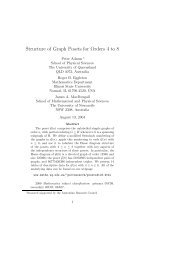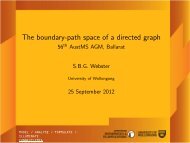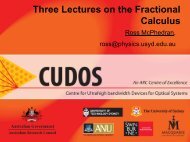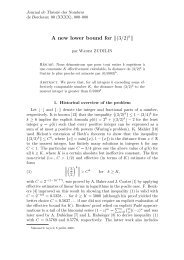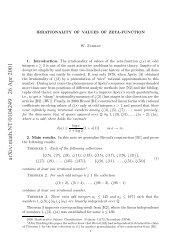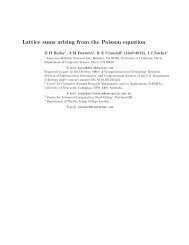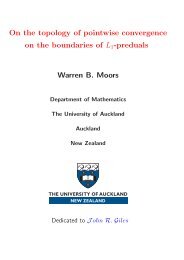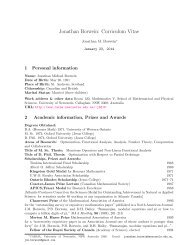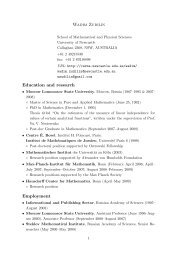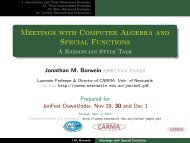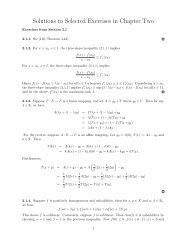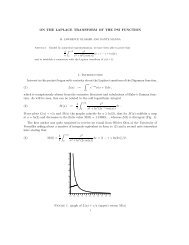QUADRATIC CONVERGENCE OF THE TANH-SINH ...
QUADRATIC CONVERGENCE OF THE TANH-SINH ...
QUADRATIC CONVERGENCE OF THE TANH-SINH ...
You also want an ePaper? Increase the reach of your titles
YUMPU automatically turns print PDFs into web optimized ePapers that Google loves.
<strong>QUADRATIC</strong> <strong>CONVERGENCE</strong> <strong>OF</strong> <strong>THE</strong> <strong>TANH</strong>-<strong>SINH</strong> QUADRATURE RULE 17Level Prob. 1 Prob. 2 Prob. 3 Prob. 4 Prob. 5 Prob. 6 Prob. 71 10 −4 10 −4 10 −4 10 −4 10 −5 10 −5 10 −62 10 −11 10 −11 10 −9 10 −9 10 −12 10 −12 10 −123 10 −24 10 −19 10 −21 10 −18 10 −28 10 −25 10 −264 10 −51 10 −38 10 −49 10 −36 10 −62 10 −50 10 −495 10 −98 10 −74 10 −106 10 −73 10 −129 10 −99 10 −986 10 −195 10 −147 10 −225 10 −145 10 −265 10 −196 10 −1947 10 −390 10 −293 10 −471 10 −290 10 −539 10 −391 10 −3888 10 −777 10 −584 10 −974 10 −582 10 −779 10 −77791011Level Prob. 8 Prob. 9 Prob. 10 Prob. 11 Prob. 12 Prob. 13 Prob. 141 10 −5 10 −4 10 −6 10 −2 10 −2 10 −1 10 −12 10 −12 10 −11 10 −12 10 −5 10 −4 10 −3 10 −23 10 −29 10 −24 10 −25 10 −11 10 −9 10 −6 10 −54 10 −62 10 −50 10 −48 10 −22 10 −15 10 −9 10 −85 10 −130 10 −97 10 −98 10 −45 10 −28 10 −19 10 −146 10 −266 10 −195 10 −194 10 −91 10 −50 10 −37 10 −267 10 −540 10 −389 10 −388 10 −182 10 −92 10 −66 10 −488 10 −777 10 −777 10 −365 10 −170 10 −126 10 −889 10 −731 10 −315 10 −240 10 −16410 10 −584 10 −457 10 −30411 10 −870 10 −564Table 1. Tanh-sinh errors at level m for the 14 test problems7.2. Non-optimality of the limiting trapezoidal rule. Finally, we examinethe optimality of the coefficient of the infinite trapezoidal rule ̂T h with ψ(x) asdefined in (1.3). Let A := {. . . , a −1 , a 0 , a 1 . . .} be the sequence of coefficients for̂T h such that̂T h;A ̂f =∞ ∑n=−∞a n ̂f(nh)for every ̂f ∈ G 2 , andÊ h;A = Î − ̂T h;AWe may ask whether A h where a n ≡ h is optimal in the sense that‖Êh;A h‖ = inf ‖Êh;A‖for all A’s for which ̂T A is a bounded linear functional. As shown in [1], A h isoptimal if and only if ̂T h integrates F nh exactly for every integer n. But from theanalysis in Section 4.1, we know ÊhF nh ≠ 0; consequently A h is not optimal.References[1] Seymour Haber, “The Tanh Rule for Numerical Integration,” SIAM Journal on NumericalAnalysis, 14 (1977), 668–685.[2] J.M. Borwein, D.H. Bailey D. H. & R. Girgensohn, Experimentation in Mathematics, AKPeters, 2004.



